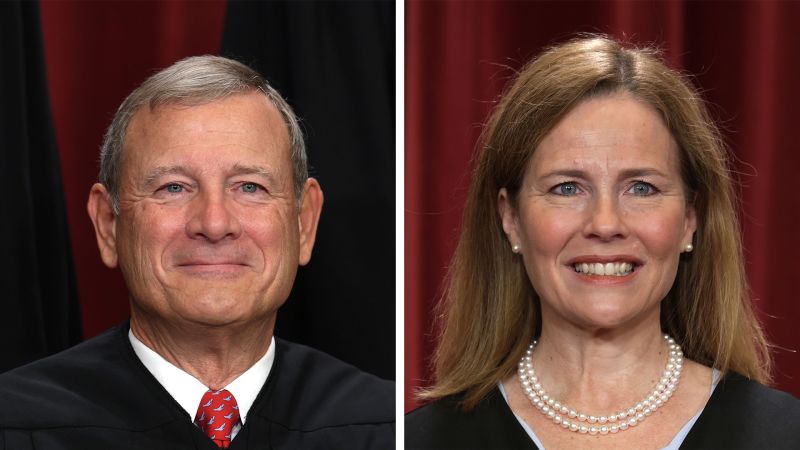Chief Justice John Roberts often downplays his influence, lamenting to a group of federal judges that he lacks the power to fire or penalize his Supreme Court colleagues. “You can’t fire people if they don’t follow you. You can’t cut their pay,” Roberts remarked on Saturday, a day after the court released its final opinions of the term. However, Roberts possesses a significant tool: the power to assign opinions for the court when he is in the majority, a position he held more than any other justice this term.
This authority is crucial because the rationale behind a Supreme Court decision sets a precedent for future cases, influencing lower court judges and shaping the legal landscape. The author of an opinion not only guides the law but also gains personal prestige. Completing his 20th session on the Supreme Court, Roberts has strategically kept pivotal cases for himself, particularly those involving presidential powers, while also using his assignment power to influence and reward colleagues.
Strategic Assignments and Surprising Choices
Roberts’ strategic maneuvers were evident last Friday when he assigned the opinion in a highly anticipated case to Justice Amy Coney Barrett. The case effectively released President Donald Trump from numerous lower-court orders blocking his policies, including efforts to alter birthright citizenship. The decision was a significant assignment for Barrett, a junior justice often criticized by Trump supporters for perceived disloyalty despite her conservative record.
The courtroom was abuzz with surprise as Justice Department lawyers and journalists exchanged glances. Many had expected Roberts to retain the opinion for himself or assign it to a more senior justice. Roberts’ choice immediately muted Trump’s criticism. “I just have great respect for her,” Trump said of Barrett, praising her “brilliantly written” decision.
For Roberts, assigning the opinion to Barrett strengthened his alliance with a pivotal justice whom liberals have attempted to sway toward the center. Both Barrett and Roberts declined to comment on the assignment.
The Power of Opinion Assignment
Like the eight associate justices, Roberts holds one vote, but he controls much of the court’s agenda by overseeing oral arguments and leading the closed-door conferences where justices discuss and vote on cases. By tradition, the most senior justice in the majority assigns the opinion, and as chief justice, Roberts enjoys seniority over all justices.
Roberts was in the majority more than any other justice last session, determining the author for 54 of the 56 signed opinions. This is the Roberts Court in both a colloquial and literal sense. Although he is rarely in dissent, notable exceptions include the 2015 decision affirming same-sex marriage rights and the 2022 decision striking down federal abortion rights.
“Roberts was in the majority on this conservative-dominated bench more than any justice last session, and he determined who would be the author of 54 of the 56 signed opinions handed down after briefing and oral argument.”
Historical Context and Comparisons
All modern chief justices have used the assignment power to influence outcomes. Chief Justice Warren Burger, who served from 1969 to 1986, often switched his vote to control the opinion, favoring colleagues who shared his ideology. His successor, Chief Justice William Rehnquist, was less manipulative and more even-handed, focusing on efficiency and rewarding justices who wrote swiftly.
Roberts, who succeeded Rehnquist in 2005, assigns opinions after each two-week sitting of oral arguments, with the public learning of assignments only when final decisions are announced. He has typically kept significant cases, especially those involving executive branch clashes, to leverage his stature as chief justice.
Until last Friday, Roberts wrote key opinions on Trump-related controversies, such as the 2018 travel ban decision and the 2019 census citizenship question case. Last session, he authored the decision granting Trump substantial immunity from criminal prosecution.
Barrett’s Emerging Influence
A former Notre Dame law professor, Barrett became Trump’s third appointee in 2020. Her cautious yet effective approach has elevated her role among the justices. Barrett sometimes casts decisive votes or drafts compromise rationales, as seen in an Idaho abortion controversy last year. Liberals have sought to draw her toward the center, often building on her questions during oral arguments.
In 2023, Roberts assigned Barrett a major Native American rights dispute, where she upheld a 1978 law favoring Native family placements in custody proceedings. The decision, seen as a progressive turn, was endorsed by Justice Neil Gorsuch, a staunch defender of Native rights.
Barrett’s role as a conciliator was evident in Friday’s Trump case, where her vote was one of six. Her opinion, echoing Justice Antonin Scalia’s originalist method, restricted district court judges from imposing nationwide injunctions on government policies. Barrett’s approach, reminiscent of Scalia’s incisive rhetoric, garnered unanimous support from conservative justices.
“Nothing like a universal injunction was available at the founding, or for that matter, for more than a century thereafter,” Barrett wrote, citing Scalia’s opinion. “Thus, under the Judiciary Act (of 1789), federal courts lack authority to issue them.”
Barrett’s ability to unify the conservative bloc contrasts with Scalia’s challenges in maintaining majorities, highlighting her growing influence on the court.
As the Supreme Court continues to navigate contentious issues, Roberts’ strategic assignments and Barrett’s evolving role will shape the judicial landscape, reflecting the intricate dynamics of America’s highest court.
